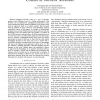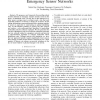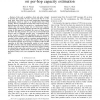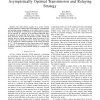INFOCOM
2003
IEEE
14 years 4 months ago
2003
IEEE
— We propose a general framework for broadcasting in ad hoc networks through self-pruning. The approach is based on selecting a small subset of hosts (also called nodes) to form ...
INFOCOM
2003
IEEE
14 years 4 months ago
2003
IEEE
Abstract— As the multicast-capable part of the Internet continues to evolve, important questions to ask are whether the protocols are operating correctly, the topology is well co...
INFOCOM
2003
IEEE
14 years 4 months ago
2003
IEEE
— Multiuser diversity refers to a type of diversity present across different users in a fading environment. This diversity can be exploited by scheduling transmissions so that us...
INFOCOM
2003
IEEE
14 years 4 months ago
2003
IEEE
— We propose a new framework for providing robust location detection in emergency response systems, based on the theory of identifying codes. The key idea of this approach is to ...
INFOCOM
2003
IEEE
14 years 4 months ago
2003
IEEE
— Service composition enables flexible creation of new services by assembling independent service components. We are focused on the scenario where such composition takes place a...
INFOCOM
2003
IEEE
14 years 4 months ago
2003
IEEE
— Tools such as pathchar, clink, and pchar attempt to measure the capacity of every Layer-3 (L3) hop in a network path. These tools use the same underlying measurement methodolog...
INFOCOM
2003
IEEE
14 years 4 months ago
2003
IEEE
— As local area wireless networks based on the IEEE 802.11 standard see increasing public deployment, it is important to ensure that access to the network by different users rema...
INFOCOM
2003
IEEE
14 years 4 months ago
2003
IEEE
—This paper is aimed at designing a congestion control system that scales gracefully with network capacity, providing high utilization, low queueing delay, dynamic stability, and...
INFOCOM
2003
IEEE
2003
IEEE
Delay Limited Capacity of Ad hoc Networks: Asymptotically Optimal Transmission and Relaying Strategy
14 years 4 months ago
— The delay limited capacity of an ad hoc wireless network confined to a finite region is investigated. A transmission and relaying strategy making use of the nodes’ motion t...
INFOCOM
2003
IEEE
14 years 4 months ago
2003
IEEE
— We investigate the problem of inferring the packet loss characteristics of Internet links using server-based measurements. Unlike much of existing work on network tomography th...




